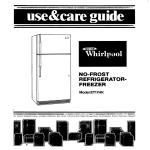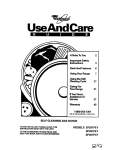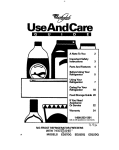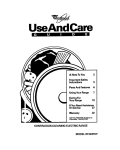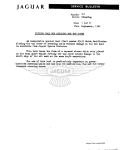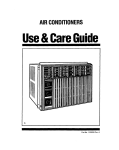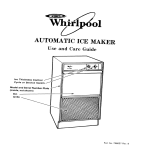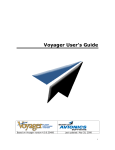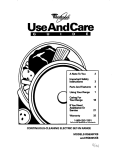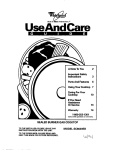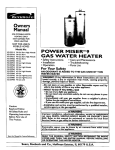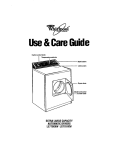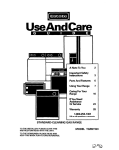Download Whirlpool SS373PEX Specifications
Transcript
Use&CareGuide surfacebumera \ ovenvent Dawn&aft Grilmodub vent I / ~eudoven h , light switch ModelandreriPl number plate - (on frame below oven) -TOTHEWT*UER:PLEA8El.EAVETWS WSTNUCTIONBOOKWlTNTHE UNT. TOTHECONWMER:PLUSERWANO KEEPTNWBOOKFOR FUTUREREFER- SELF-CLEANING DOWNDRAFTSLIDE-INGASRANGE SS373PEX Contents Page Safely Instructions ....... .3 Using Your Range .......................... 6 Important Using the surface burners ............. .6 Using the grill ................................ .7 Using the optional griddle ............. .B Using the optional rotisserie ......... 10 Using the vent system.. ................ 12 Changing surface burner module. 12 Setting the electronic clock ......... .14 -Setting the electronic Minute Timer ............................ 14 Using the oven controls.. ............. .15 Baking/roasting ......................... 15 16 Broiling ...................................... Using the Cook Timer ................. .16 The oven vent .............................. 22 The storage drawer.. ................... .23 Thank you ~plianca the Owner vided with for buylng a Whirlpool please complete and mail Registration Csrd prothis product. Then complete the form below. Have thii inf0mah ready Y you need senrice or call with a question. l Copy model and serial numbers from plate (on frame behind the storage drawer) and purchase date from sales slip. l Keep this book the Cooking Guide and sales slip together in the Literature Pac. Model Numbor Caring For Your Range ............... .24 Control panel and knobs ............. .24 Surface burner grates and burner 24 caps .......................................... Surface burners.. ......................... .25 26 Grill ............................................... Vent system ................................. 27 Using the SelfCleaning cycle .... ..2 9 Cleaning tips ................................ 34 The oven light.. ............................ .36 Removing and replacing your range ................................... .37 II You Need Service Or Assistance .................................... .37 Whirlpool Cooking Product Warranty ....................................... .40 Q1992 Whirlpool Corporation 6e1rial Number Purchase Service Date Company Phone Number You are responslbla for: l l l l l Installing and leveling the range on a floor strong enough to support its weigM, and where it is protected from the elements. (See the Installation Instructions.) Making sure the range is not used by anyone unable to operate it properly. Properly maintaining the range. Using the range only for jobs expected of a home range. Making sure the range is secured by properly installed anti-tip bracket(s), with rear leveling leg(s) positioned under bracket(s). ImportantSafetyInstructions Gas ranges have been thoroughly tested for safe and efkiint operation. However, as with any appliance, there are specifii installation and safety precautions which must be followed to ensure safe and satisfactory operation. WARNING: lf the information In this manual Is not followed exactly, a fire or explosion may result causing property damage, personal Injury or death. DO NOT STORE OR USE GASOUNE OR OTHER FLAMMABLE VAPORS AND UQUIDS IN THE VICINIlY OF THIS OR ANY OTHER APPUANCE. WHAT TO DO IF YOU SMELL GAS: l DO NOT TRY TO UGHT ANY APPUANCE. l DO NOT TOUCH ANY ELECTRICAL SWlTCH; DO NOT USE ANY PHONE IN YOUR BUILDING. l IMMEDlATELY CALL YOUR GAS SUPPUER NEIGHBOR’S PHONE. FOLLOW THE GAS SUPPUER’S INSTRUCTIONS. l IF YOU CANNOT REACH YOUR GAS SUPPUER, CALL THE FlRE DEPARTMENT. FROM A INSTALlATlON AND SERVICE MUST BE PERFORMED BY A QUALlFlED INSTALLER, SERVICE AGENCY OR THE GAS SUPPUER. 3 Important Safety Instructions Continued l Install or locate the range onty in accordance with the provided Installation Instructions. The range must be installed by a qualified installer. The range must be properly connected to the proper gas supply and checked for leaks. The range must also be property connected to electrical supply and grounded. WARNING: To reduce the risk of tipping of the appliance, the appliance must be secured by properly installed anti-tip bracket(s). To check if the bracket(s) is installed properly, remove the storage drawer (see page 23) and verify that the anti-tip bracket(s) is engaged. l Gas fuels and their use in appliances can cause minor exposures to benzene, formaldehyde, carbon monoxide and soot, primarily from incomplete combustion. Significant exposure to these substances can cause cancer or reproductive harm Properly adjusted burners with a blue, rather than a yellow, flame will minimize incomplete combustion. Venting with a hood or an open window will further minimize exposure. . Do not operate the range il it is damaged or not working properly. . Do not use the range for warming or heating the room. Persons could be burned or injured, or a fire could start. ’ Do not attempt to light the oven burner during a power failure, Personal injury could result. Reset oven controls to the off position in the event of a power failure. l 4 Use the range only for its intended use as described in this manual. l Do not wear loose or hanging garments when using the range. They could ignite if they touch a hot surface burner and you could be burned. 9 DO NOT TOUCH SURFACE BURNERS, AREAS NEAR BURNERS OR INTERIOR SURFACES OF OVEN. Areas near surface burners and interior surfaces of an oven become hot enough to cause bums. During use, do not touch, or let clothing or other flammable materials contact surface burners. areas near surface burners or interior surfaces of oven. Other surfaces of the range may become hot enough to cause burns; such as, the oven vent opening, the surface near the vent opening, the cooktop, the oven door and window. l Make sure the utensils you use are large enough to contain food and avoid boilovers and spillovers. Heavy splattering or spillovers left on a range can ignite and burn you. Pan size is especially important in deep fat frying. l Turn pan handles inward, but not over other surface burners. This will help reduce the chance of bums, igniting of flammable materials, and spills due to bumping of the pan. l Use only dry potholders. Moist or damp potholders on surface burners may result in burns from steam. Do not let potholder touch surface burners. Do not use a towel or bulky cloth for a potholder. It could catch on fire. l Check to be sure glass cooking utensils are safe for use on the range. Only certain types of glass, glass-ceramic, ceramic, earthenware or other glazed utensils are suitable for ranges without breaking due to the sudden change in temperature. l l Never use a match or other flame to Do not use decorative covers or look for a gas leak Explosion and trivets over the surface burners. injury could result. l Do not heat unopened containers. l Know where your main gas shutoff They could explode. The hot valve is located. contents could cause burns and container particles could cause l Keep range vents unobstructed. injury. l Clean your range regularly. See l Grease is flammable. Do not allow care and cleaning instructions in this grease to collect around cooktop or manual. in vents. Wipe spillovers immedil Do not clean door seal. lt is essenately. tial for a good seal. Care should be l Do not use water on grease fires. taken not to rub, damage, or move Never pick up a flaming pan. the seal. Clean only parts recomSmother flaming pan on range by mended in this Use and Care Guide. covering with a well-fitted lid, cookie l Small amounts of formaldehyde and sheet or flat tray. Flaming grease carbon monoxide are given off in the outside of pan can be extinguished Self-Cleaning cycle from fiberglass with baking soda or. if available, a insulation and food decomposition. multipurpose dry chemical or foamSignificant exposure to these type extinguisher. substances can cause cancer or l Never leave surface burners reproductive harm Exposure can be unattended at high heat settings. A minimized by venting with a hood or boilover could resuft and cause open window and wiping out excess smoking and greasy spillovers that food spills prior to selfcleaning. may ignite. l Do not use oven cleaners. No l Use care when opening oven door. commercial oven cleaner or oven Let hot air or steam escape before liner protective coating of any kind removing or replacing food. should be used in or around any part of the oven. l Always position oven rack(s) in desired location while oven is cool. l Before seffcleaning the oven, remove broiler pan, broiler grid, l Do not store flammable materials on oven racks and other utensils. Do or near the range. The fumes can not use your oven to clean miscellacreate an explosion and/or fire neous parts unless you are inhazard. strutted to do so in this Use and * Do not use the oven for storage. Care Guide. l Do not store things children might l Do not repair or replace any part of want above the range. Children the range unless specifically could be burned or injured while recommended in this manual. All climbing on it. other servicing should be referred to l Do not leave children alone or a qualified technician. unattended in area where the range l Disconnect the electrical supply is in use. They should never be before servicing the range. allowed to sit or stand on any part of the range. They could be burned or injured. -SAVE THESE INSTRUCTIONS l 5 UsingYourRange Using the surface burners Your cooktop is equipped with electric ignitots. Electrii ignitors automatically light the burners each time they are used. Control knobs must be pushed In and turned to the LITE position. The clicking sound is the ignition sparking. Visually check that burner has lit To stop the clicking sound after the burner lights, turn the control knob back to a desired setting. The control knob has stops for HI, medium and low, however, it can be set anywhere between HI and OFF. Surface burner markers The solid dot in the surface burner marker shows which surface burner is turned on by that knob. Burner heat settings Until you get used to the settings, use the following as a gukfe. For best results, start cooking at the high settings; then turn the control knob down to continue cooking. Use LfTE to light the burner. After the burner lights, turn control back to a desired setting to stop the clicking of the ignition. Use HI to start foods cooking; to bring liquids to a boil. Use a medium setting to continue cooking or to fry chicken or pancakes: for gravy, pudding and icing; to cook large amounts of vegetables. Use a low setting to keep food warm until ready to serve. NOTE: Do not cook with the control in the LITE position. Use correct burner heat settings. If the heat setting is too high, it can: l Char bacon and cause curling. l Make eggs tough and crisp at the edges. l Toughen liver, fish and seafood. l Scorch delicate sauces and custards. l Cause a boilover. In case of a probnged power failure: Surface burners can be manually lighted. Hold a lighted match near a burner and turn the control to the LITE position. After the burner lights, turn the control to the desired setting. NOTE: GrflVgriddle burners should not be manually lighted during a prolonged power failure. Since the vent system will not operate, smoke and steam will not be vented out of the room- l l l Bum, Flm and ExplosJon Hazard Burner flame should not extend beyond the edge of the cookfng utensil. The flame can bum you and causa poor ccoldng results. Be l ure all control knobs are turned to Off when you are not cooktng. Someone could be burned or a fire could start if a burner is accidentally left ON. If the flame should go out while cooking, or if there is a strong gas odor, turn the bumem Off. Walt five minutes for the gas odor to disappear before rellghtlng burner. # gas odor Is still present, see safety note on page 3. Failure to follow these precautions could result In explosbn or fire. Using the grill The grill will work only on the right side of the cooktop. Before you use the grill for the first time: Wash with warm soapy water, rinse and dry. Never use a metal scrubbing pad or abrasive cleanser on the grill; these will damage the non-stick surface. After cleaning, lightly wipe cooking surface with cooking oil to prevent food from sticking. Cooking tips Do net cover ths entire cooking surface with meat- Leave space between the food -kerrrs to allow smoke and steam to ventilate properly. Meat with a normally high fat content will produce more smoke and flare-ups, but cook faster than lean meat. Trim fat from meat before placing on the grill to prevent excessive smoke or flare-ups. If meat begins to cook too quickly, turn the grill control knob to a bwer setting. Do not leave grill unattended. NOTE: The use of metal utensils can scratch the non-stick coating. Only nylon or plastic utensils should be used. When using nylon or plastic utensils, do not leave them on the grill. They may melt- Fire and Bum Haxard . tf grease causes excessive flareups Do NOT PUT WATER ON A GREASE FIRE. To put out fire: -Remove food from the grill, turn the grill control to OFF and cover the grill with a large metal pan-Make aura the vent system has been switched to ON. mDo not light the grtlVgrfddle burners during a ljowar failure. The vent system will not work if there Is a power failure. This prevents proper venting for adequate cooling of the grilU griddle burners. The resulting heat build-up can cause fire. l Do not use pots or pans on grill They will become very hot and can bum you. 7 Using Your Range Continued Grill chart Preheat 10 minutes on HI for best flavor. FOOD I CONTROL SEll-lNG APPROXIMATE COOKING TlME SIDE 1 1 SIDE2 COMMENTS 4Mh 6 Mh. 7 Mh. 5Mh. 6Mh. 7 Mh. Med. Med. Med. 4 Mh. I 3SMh. 3Mh. TUllfSneededt~l3VWlaoa#l0. 25Mh. Lamb chop Med. Chlcken pbcea Med. Turn fmqtwWy. Hmllouca Med. TumesnmdedlorevenoxAhg. 15 Mh. Grilling times are approximate I 10 Mh. TumasnmdedlorevenaDddng. and may need to be adjusted to individual tastes. Using the optional griddle The optional griddle module will work only on the right side of the cooktop. l l l Burn, Fire and Product Damage Hazard Be sure the griddle control is off and the griddle is cool and covered when not in use. Failure ;;,“o so could result In burns or When cleaning griddle, never use a metal scouring pad or abrasive cleanser on the griddle. These will damage the non-stick surface. Do not use cookware on the griddle. Use only plastic or nylon kitchen utensils on the griddle. Metal can damage the non-stick cooking surface. Before using the griddle for the first time: 1. The cooking surface should be washed with warm, soapy water, rinsed and dried. 2. After cleaning, lightly wipe the cooking surface with cooking oil to prevent food from sticking. You do not have to season (grease) the griddle every time you use it. Be sure to use only cooking oil (not shortening or butter) to season the griddle. 3. Preheat on HI, then turn control to a lower setting to cook 4. Place food directly on cooking surface. 5. Turn off the griddle burner when cooking is finished. Leaving burner on will damage the griddle. Griddle chart Preheat on HI, then turn to a lower setting to cook Griddle cooking times are approximate tastes. and may need to be adjusted to individual Using Your Range Continued Using the optional rotisserie Burn and Electrical Shock Hazard Make sure the grill controls are OFF and the grill is cool before installing the rotisserie. Failure to do so could result in burns or electrical shock The optional rotisserie will work only on the right side of the cooktop. To install: 1. Remove the grill sections. 2. Set in rotisserie rack. 3. Install rotisserie motor as shown. To remove: 1. Lift rotisserie motor off the rack and set aside. 2. Remove the rack and set aside. 3. Replace the grill sections. Power cord 10 To put mat on apit 1. Put fork on the spit pointing away from the handle. 2 Push spit through meat so the weigM is balanced around the center. 3. Put the second fork on the spit pointing toward the meaL 4. Push both forks into the meat and tighten the thumbscrews. 5. Push the pointed end of the spit all the way into the motor socket 6. Put the handle end of the spft into the rack slot. 7. Plug in and turn on the rotisserie motor. Turn on the grill module. See chart below for suggested cookfng times. No preheating is required The individual burner controls hep provide extra heat control. HVMedlum combination settings can be used for best cookfng results. ‘Be sure grill sections are removed during rotisserie cooking. “Roasts of approximatefy S-3% pounds are the most suitable for rotfsserie cooking. Larger roasts will greatly increase cooking times. 11 Uslng Your Range Continued Using the vent system Using the co&top’s built-in downdraft vent fan removes cookfng vapors, odor and smoke. The fan wffl always come on at LOW speed when the grill module is in use, but may be manually switched to HIGH. The fan cannot be turned off when the grill module is operating. When using surface units, turn the Vent Fan Control Knob clockwise to HIGH or LOW. You will hear a click when the fan comes on. Turn counterclockwfse to turn the fan OFF. The fan filter must be in place for the fan to operate proparly. Personal Injury Hazard Do not put hands In vent box when fan or controls are on. The vent fan system turns on automatically when the grill is uti Turn fan and cooktop controls to Off. Failure to do l o could resuft In personal Injury. Cty;u ;g surface burner 9 The surface burner module will work on both sides of the cooktop. (Gee page 26 for grill removal instructions.) Bum and Electtlcaf Shock Hazard Be sure all controls are off and the module ls cool before handling rnodula Failure to do so could result in bums or electrical shock To remove surface burner module: 1. Lfft off surface burner grates and caps2. Lift slightly by the handle. 3. With both hands, pull module toward you to clear oriiices (gas lines). Lift Out. To replace module: 1. Line up the venturi (burner inlet tubes) with the burner orifices. 2 Push the module until it is seated property. 3. Lower front with the handle. 4. Instatl surface burner caps and grates. To Install optlonal griddle module: The griddle module will work only on the right side of the cooktop. 1. Remove the grill sections. 2. Place the griddle over burners with drain slot in back To remove module: 1. Lift front slightly by both front comers and set aside. 2 Replace the grill sections. 13 Using Your Range Continued Setting the electronic clock The electronic clock is a 24-hour digital clock with a Minute Timer and automatic control cooking cycle. Time of day, Minute Timer times and cook times are set by pushing command buttons on either side of the display. for any setting after I 2 o’clock noon. Setting the electronic Minute Timer The Minute Timer does not start or stop the oven. It works like a kitchen timer. It can be set in hours and minutes up to 9 hours 59 minutes. When the set time is up, you will hear a Ssecond on and ‘X-second off tone and the lower dot in the middle of the display will flash. Push the Minute Timer button to cancel the tone and flashing dot. the display will light up, indicating that the Minute Timer is on. 3. The display will show the set time, then return to time of day. 4. To see the remaining set time before the set time is up, push the Minute Timer button. 14 To cancel the Minute Timer: Push the Minute Timer button, followed by the Up or Down buttons until “000” shows on the display. Using the oven controls Baking/roasting 1. Position the rack(s) properly before turning on the oven. To change reck position, pull rack out to stop, raise front edge. and lift out. When using one rack, the rack should be placed so the top of the food will be centered in the oven. Always leave at least 1 ‘h to 2 inches (4-5 cm) between the sides of the pan and the oven walls and other pans. For more information, see the Cooking Guide. 2. Set the Oven Selector to BAKE. The OVEN Indicator Light will come on. 3. Push in and turn the Oven Temperature Control to the baking/roasting temperature you want. The oven burner will automatically light in 50-60 seconds. 4. When baking, preheat the oven for 10 minutes. Put the food in the oven. NOTE: Do not preheat when roasting or cooking items such as casseroles. Do not place food directly on the oven bottom. 5. During baking/roasting, the oven burner will turn on and off to maintain the temperature setting. The OVEN Indicator Light will turn on and off with the burner. 15 Uslng Your Range Continued Brolllng Refer to the Cookfng Guide for additional broiling information. 1. Position the rack before turning the oven on. Refer to the chart on page 18 for recorrrnended rack positions. 2. Preheat the broiler for 5 minutes before using. Do not preheat with broiler pan in place. 3. To preheat, set the Oven Selector to BROIL Push in and turn the Oven Temperature Control to BROIL The OVEN Indicator Light will come on. 4. After preheating, put the broiler pan and food on the rack 5. Completely close the oven door to assure proper broiling temperatures. 16 Broiling tips l l l l l l l l l Use the broiler pan and grid for broiling. They are designed to drain excess liquid and fat away from the cookfng surface to help prevent spatter, smoke or fire. lf you broil small quantities, you may want to use a small brofler pan. They are available in the housewares seqbn of many department stores. For best broiling resufts, preheat at BROIL for 5 minutes. Do not preheat with broiler pan in pl-. Rack position determines how infrared rays cook your food. The bwer the position. the more broiler grid area covered by the rays. See “Broiling rack position chart” on next page for more information. To sear meat, place broiler pan at one of the higher rack positions so that meat ls very near the flame. Small steaks may be broiled in the higher rack posftions. To cook large steaks and other thick cuts of meat well done, move them to a lower rack position after searfng. Refer to a broiling chart in a reliable cookbook for correct broiling times. After broiling, remove the broiler pan from the oven when you remove the food. Drippings will bake on the pan if it is left in the heated oven. l l FireHazard Piaca meat the correct dlstancs from the burner. Meat placed too close to the burner may spatter, smoke, bum or catch fire during broiling. To ensure adequate grease drainage, do not use cookia sheets or similar pans for brollina Aho. covering the broiler grid with foll h not recommended. Poor dralnege of grease may result In fire. If foil is us4 cut slits In foil to correspond wfth all openings In broller grid. Grease can then drain away and cool In pan. 17 Broiling reck position chart FOOD r 4 Rare steaks and fish 3 Medium and weiidone steaks and ha&urgers; weiidone foods such as chicken, lobster. ham slices and pork chops Using the CookTimer The automatic Cook Tiir is designed to turn the oven on and off at times you set, even when you are not around. Automatic baking/roasting is ideal for foods which do not require a preheated oven such as meats and casseroles. Do not use the automatic cycle for will r&it. To start bekfnglroasting dop automticaiiy: now and 1. Position rack(s) properly, and place the food in the oven. 2. Make rure the clock is eet to the correct time of day. (See setting the electronic ciocK on page 14.) 4. Push in and turn the Oven Temperature Control to the baking/roasting temperature you want. 5. Push the Stop Time button. 6. Push the Up button to set the desired stop time. AUTO and the Power On symbol (the vertical box under PW) will appear on the display and the OVEN indicator Light will come on to signal the start of the coolong cycle. When the desired stop time is reached, the Power On symbol and the OVEN indicator tight will go off, a 1O-second tone will sound and the display will return to the current time of day. The AUTO light will flash on and off until the CanceLClock button is pushed. The oven will shut off automatically. 7. After baking/roasting ie done or to cancel the setting at any time. push the CanceVClock button and turn both the Oven Selector and the Oven Temperature Control to OFF. To delay start and etop automaticaity: 1. Position the oven rack(s) properly. and place the food in the oven. 2 Make cure the clock is eet to the correct time of day. (See Setting the electronic clocK on page 14.) 3. Set the Oven Selector to TIMED BAKE. 4. Push in and turn the Oven Temperature Control to the baking’roasting temperature you want. 19 Using Your Range Continued 6. Immediately push the Up button to set the desired stop time. AUTO will appear on the display and the clock will automatically calculate the start time. (In example at left, a three-hour timed bake/roast cycle with a stop time of 5:00 would begin at 2:O0.) When the desired start time is reached, the Power On sytiol and the OVEN indicator Light will come on indicating that the timed bake/ roast cycle has begun. NOTE: ff you do not set a stop time immediately, AUTO will appear on the display and you will be unable to program the stop time. You must then start over by pushing the CancelClock button and reentering the baking/roasting time. 9. When the desired stop time is reached, the Power On symbol and the OVEN Indicator Light will go off, a 1O-second tone will sound and the display will return to the current time of day. The AUTO light will flash on and off until the CancelClock button is pushed. The oven will shut off automatically. 20 1 10. After baking/roasting is done or to cancel the oetting at any time, push the CanceVCfock button and tom both the Oven Selector and the Oven Temperature Control to OFF. To avoid ricknaso and food waste when using the delay eta* . Do not let most UNFROZEN food rtend for more than two houm before cooking starts. l Do not allow food to remain in oven for more than two houm after the end of the cooking cycle. NOTE: Do not use foods that will spoil while waiting for cooking to start Such foods are: dishes with milk or eggs. cream soups, and cooked meats or fish. Also, foods containing baking powder or yeast will not rise properly when cooked using delay start. 21 Using Your Range Continued The oven vent Hot air and moisture escape from the oven through a vent located at the beck of the cooktop. The vent is needed for air circulation. Do not block the vent. Poor baking/ roasting can result. NOTE: Never store plastics. paper or other items that could melt or bum near the oven vent, or any of the surface burners. Bum Hazard When the oven is ON, pans and pan handier ieft near the oven vent can become hot enough to bum the user and to melt plastics. Use potholders to move pans. 22 The storaue drawer The storage d;awer is for storing pots and pans. The drawer can be removed to make it easier to clean under the range, and to check for installation of the anti-tip bracket(s). Use care when handling the drawer. Removing the storage drawer: 1. Empty drawer of any pots and pans before removing drawer. Pull drawer straight out to the first stop. Lift front and pull out to the second stop. 2. Lii back slightly and slide drawer all the way out. Replacing the storage drawer: 1. Fti ends of drawer slide rails into the Drawer slide drawer guides on both sides of opening. 2. Lift drawer front and push in until metal stops on drawer slide rails clear whiie stops on drawer guides. Lift drawer front again to clear second stop and slide drawer closed. rail Literature P= Use and care guide storage Store this booklet, along with your Cooking Guide and sales slip in the Literature Pat, inside the storage drawer. To verify that the anti-tip bracket(s) is engaged: Remove storage drawer. Look to see if the anti-tip bracket(s) is attached to floor with screw-s. l Make sure rear leveling leg(s) is positioned under bracket(s). l See ‘Important Safety Instructions” on page 3 and Installation Instructions for further details. NOTE: The range will not tip during normal use. Tipping can occur if excess’we force or weight is applied to open door without anti-tip bracket(s) properly secured. l l 23 CaringForYourRange Burn, Electrical Shock Fire and Explosion Hazard l Make sure all controls are OFF and the range is cool before cleaning. l Do not use oven cleaners, bleach or rust removers. l Do not obstruct the flow of combustion and ventilation air. Failure to follow these guidelines could resuit in burns, electrical shock, fire or explosion. Control panel and knobs 1. Make sure all control knobs are turned to off. 2. Pull control bobs straight off. 3. Use warm, soapy water and a sponge or spray glass cleaner and a paper towel to wipe the control panel. Rinse and wipe dry with a soft cloth. 4. Wash control knobs with warm, soapy water and a sponge. Rinse well and dry with a soft cloth. Do not soak. 5. Replace control knobs by pushing them firmly into place. NOTE: When cleaning, never use steel wool, abras’wes, or commercial oven cleaners which may damage the finish. After cleaning, make sure all control knobs point to OFF. Surface burner grates and burner caps 1. Make sure all surface burners are off and the surrounding parts are cool. 2. Lift off the burner grates. 24 3. Lift off the burner caps. 4. Wash the grates and caps with warm, soapy water or in a dishwasher, Use a nonabrasive scrubbing pad for cooked-on foods. Rinse and dry well. 5. Replace the burner grates and burner caps. Surface burners Remove surface burner cover. To remove cover, push in buttons on the sides while lifting the cover. Wipe off surface burners, cover and burner pan with warm, soapy water and a sponge after each use. Use a plastic scrubbing pad for cooked-on foods. If burner ports are clogged, clean with a straight pin. Do not enlarge or distort the ports. Do not use a toothpick clean the ports. Typical surface burner flame at highest setting to Occasionally check the burner flames for proper size and shape as shown. A good flame is blue in color. If flames lift off ports, are yellow, or are noisy when turned off, you may need to clean the burners (see above or “Cleaning tips” on page 34) or call a qualified technician for adjustment. Replace surface burner cover. 25 Caring For Your Continued Range Grill Food cooked on the grill may spatter. All parts of the module should be cleaned after each use. To remove grill: 1. Make sure all controls are off and the grill is cool. 2 Lift off grill sections. 3. Lift front end of burner pan and pull toward you. Venlurf 4. With both hands, lift burner pan out and set aside. 5. Lift out the grease pan, being careful not to spill fat drippings. 26 Wash all module parts with warm, soapy water and a nonabraske plastic scrubbing pad or in a dishwasher. Rise and wipe dry. Do not use metal scrubbing pads or abrasive cieansers. They will scratch the non-stick finish. To replace grill: 1. insert the grease pan. Do not use the grill module unless the grease pan is in place. insert grease pan only on the right side of the cooktop. The grill will work onty on the right side of the cooktop. 2. Line up the venturi with the burner OdiieS. 3. Push burners into place while lowering burner pan. 4. Place grill sections over burners. Vent system Personal Injury Hazard Disconnect the electrical supply befors servicing the rsnge. l Turn fan and cooktop controls to OFF before cleaning the vent system The vent fan system turns on autornaticsiiy when the grill is used. Do not put hand in vent box when fan or controls are on. Failure to follow these instructions could resuit in personal 1 Wry. l 27 Caring For Your Range Continued 1. Remove the vent cover and wash in warm, soapy water or wipe with a damp sponge. Do not use metal scrubbing pads or abrasive cleansers. 2. Lift up vent fitter, which is directly below vent cover. Wash in warm, soapy water or dishwasher. 3. Wipe in and around the vent box with a damp sponge. Spills should be cleaned up with a sponge. 4. Replace the fitter. Be sure the fitter is replaced flat and rests on side edges of trim Filter should not be replaced et an angle. 5. Replace the vent cover. NOTE: filter must be in place for the fan to operate properly. Replacement filters can be ordered from a WhirlpoolW service company or dealer. Order Part Number 786220 (one pair). In the event you are unable to obtain the name of a local authorized Whirlpool service company, call Whir@ool Consumer Assistance Center, TOLL-FREE 1-800-253-l 301. 28 ;;;s the Self-Cleaning The Se&Cleaning cycle uses very high heat to burn away soil. Before you start, make sure you understand exactly how to use the Self-Cleaning cycle safely. Before you start 1. Handclean the indicated areas. They do not get hot enough during the Self-Cleaning cycle for soil to burn away. Use hot water and detergent or a soapy steel-wool pad on ... l The inside of the door around the edge. (The window may also require hand-cleaning.) l The frame around the oven. Do not clean, move or bend the fiberglass seal. Poor cleaning and poor bakingroasting will result. 2. Remove the broiler pan and any pots and pans you may have stored Hand&an frame I Hand-clean door around edge DO NOT hand-clean 1 seal in the oven. NOTE: The broiler pan (without grid) can be cleaned in the oven if most of the soil is removed by hand-cleaning or a dishwasher. The chrome broiler grid will discolor if cleaned in the SelfCleaning cycle. 3. Wipe out any loose soil or grease. This will help reduce smoke during the Self-Cleaning cycle. 4. Remove the oven racks from the oven if you want them to remain shiny. If the oven racks are cleaned in the Self-Cleaning cycle, place them on the second and fourth rack guides. (Guides are counted from bottom to top.) lf oven racks are cleaned in the Self-Cleaning cycle, they will become harder to slide. (See page 35.) Heat and odors are normal during the Self-Cleaning cycle. If needed, remove them by opening a window or by turning on a vent hood or other kitchen vent during the cycle. 29 Caring For Your Range Continued l l l Personal Injury and Product Damage Hazard Do not touch the oven during the Self-Cleaning cycle. Wcould burn you. Do not use commercial oven cleaners In your oven Cleaners may produce hazardous fumes or damage the Porcelain finish. Do not leave toll In the oven. During the Setf-Cleanlng cycle. Foil can bum or melt and damage the oven surface. NOTE: Do not force the Lock Lever. You could bend or break it. The lever is designed to stay locked until the oven is cool enough to safely open. Wait until it moves freely. Do not block the vent during the SelfCleaning cycle. Air must move freely for best cleaning results. Do not leave plastic utensils near the vent. They my melt. Setting the controls To start the Self-Cleaning cycle immediately: 1. Set the Oven Selector to CLEAN. 2. Make sure the clock has the conect time of day. 3. Move the Lock Lever all the way to the right-the Clean position. NOTE: The fan will come on automatically when the Lock Lever is moved to the Clean position. 30 Use 3-4 hours for heavy soil. The OVEN Indicator LgM will come on immediately. The CLEAN Indicator tight will come on when the oven temperature exceeds normal baking/ roasting temperatures. The door cannot be opened when the CLEAN Indicator Light is on. l 3. Move the Lock Lever all the way to the right-the Clean position. l Use 3-4 hours for heavy soil. 31 Caring For Your Range Continued Cleaning cycle with a stop time of 500 would begin at 2:O0.) When the desired start time is reached, the Power On symbol and the OVEN Indicator tight will come on indiiating that the SetMeaning cycle has begun. The CLEAR Indicator Light will come on when the oven temperature exceeds normal baking roasting temperatures. The door cannot be opened when the CLEAN Indicator Light is on. At the end of the Self-Cleenlng cycle: 1. After the Setf-Cleanlng cycle Is completed, both indicator lights will go off, a 1O-second tone will sound and the display will return to the current time of day. The AUTO light will flash on and off until the Cancel/ Clock button is pushed. Wait until the oven reaches normal baking roasting temperatures (about 30 minutes) before attempting to move the Lock Lever back to the left. DO NOT FORCE fT. Waif until if moves 32 Special l l l l tips Keep the kitchen well ventilated during the Self-Cleaning cycle to help get rid of heat, odors and smoke. After the oven is cool, wipe up any residue or ash with a damp cloth. Clean the oven before it gets heavily soiled. Cleaning a very soiled oven takes longer and results in more smoke than usual. If the Self-Cleaning cycle does not get the oven as clean as you expected, the cycle may not have been set long enough or you may not have prepared the oven properly. Set the SelfCleaning cycle longer the next time and hand-clean areas noted on page 29. During the Seff-Cleaning cycle, the oven gets much hotter than it does for baking or broiling .. . approximately 875°F (468°C). This heat breaks up grease and soil and burns it off. This graph shows approximate temperatures and times during a SetfCleaning cycle for 2!4 hours. Self-Cleaning (Approximate cycle - 2% hour temperatures setting and times) 1ooO”F 634°C 600°F 427-c COD’F 216% 400-F 204% 200°F WC I START llllw. I 1 tw. I 11nlvr I 2h I 21Rlnm Slur STOP Notice that the heating stops when the 2% hour setting is up, but that it takes longer for the oven to cool down enough to unlock. 33 Caring For Your Range Continued Cleaning tips control knob Clean with warm, soapy water and a sponge. l Wash, rinse and dry well. l Do not soak Surface burner gratee and cape Clean with warm soapy water and a nonabrasive phstic scrubbing pad or cleanser. l Wash, rinse and dry well. l DC not use abrashre or harsh cleansen. Control panel Grilllgrlddle Clean with warm, soapy water and a sponge or spray glass cleaner and a paper towel. l Wash, rinse and dry well. l Follow directions provided wtth the cleaner. Clean gtilVgriddle with warm. soapy water and a nonabrasive plastic scrubbing pad. . Wash, rinse and dry. l Do not use metal scouring pads or harsh cleansers. l All parts are dishwasher-safe. Exterior eurfacw (other than control panel) Clean wfth warm soapy water and a sponge. l Wipe off regularly when cooMop and oven are cool. Use a nonabrasive plastic scrubbing pad for heavily soiled areas. l Do not use abrasive or harsh cleansers. NOTE: Do not allow food containing acids (such as vinegar, tomato or lemon juice) to remain on surface. Acids may remove the glossy finish. Also, wipe up milk or egg spills when cooktop is cool. Surface burners. burner cover and burner pan Clean with warm soapy water and a sponge. l l Remove burner cover (see page 25). Wipe off spills immediately after burner has cooled. For cookedon fcodz l l l Wash with warm soapy water and a plastic scrubbing pad. Rinse and dry well. lf ports are clogged, clean with a straight pin. Do not enlarge or distort poh Do not use a wooden toothpick. l Do not clean surface burner in dishwasher. 34 Rotlsaerie Clean rack and spit with warm, soapy water and a sponge or nonabrasive plastic scrubbing pad. . Clean after each use. l Wash, rinse and dry well. Clean motor with warm soapy water and a sponge. l Do not put in water. l Unplug before cleaning. l Wipe clean after each use. Vent system Oven Clean cover and filter with warm, soapy water and a sponge or in a dishwasher. l Clean often. l Wash, rinse and dry well. Clean vent box with warm, soapy water and a sponge. l Clean often. l Wipe out grease residue with a sponge. Sponge out spills. Use spray glass cleaner and a paper towel or warm, soapy water and a nonabrasive plastic scrubbing pad. l Make sure oven is cool. l Follow directions provided with the cleaner. l Wash, rinse and dry well. Broiler pan and grid Clean with warm, soapy water or a soapy steel-wool pad. l Clean after each use. l Wash, rinse and dry well. l Do not clean in Self-Cleaning Oven. (See note on page 29.) Oven door Self-Cleaning glass oven For areas outside the Self-Cleaning area use warm, soapy water or soapy steel-wool pads. l Follow directions starting on page 29, “Using the Self-Cleaning cycle.” l Do not use commercial oven cleaners. l Do not use foil to line the bottom of your Se&Cleaning Oven. racks Use Self-Cleaning cycle. l Leave in oven during SeCCleaning cycle. OR Clean with warm soapy water or soapy steel-wool pads. l Wash, rinse and dry. Use soapy steelwool pads for heavily soiled areas. NOTE: The oven racks will permanently discolor and become harder to slide when left in the oven during the SelfCleaning cycle. Apply a small amount of vegetable oil to the side rungs to aid sliding. 35 Caring For Your Range Continued The oven light The oven IigM w?l come on when you push the Oven tight Switch on the control panel. Push the switch again to turn off the light. Elect&al l l Shock and Pereonal Injury Hazard Make sure oven and light bulb ate cool and Power to the oven has been turned OFF before replacing the light bulb. Failure to do so could reeutt in electrical shock or bums. The lens must be in place when using the oven. The lens protects the bulb from brealdng, and from hlgh oven temperatures. Because lens is made of glass, be careful not to drop it. Broken glass could cause iniuw To replace the oven light: 1. Turn off power at the main power supply2 Unscrew lens from housing. 3. Unscrew light bulb and replace with a 40+&l appliance bulb. 4. Replace the lens. 5. Turn on power at the main power WPly. NOTE: The oven IigM will not work during the Self-Cleaning cycle. 36 Removing and replacing your range lf the range is removed after installation, you must follow this procedure: 1. Remove storage drawer. 2 Shut off main gas supply valve to range. 3. Disconnect electrical supply cord. 4. Disconnect downdraft ductwork from fan motor to transition. (See Inetalla- tion Inetructione.) 5. Disconnect the range from the main gas supply lie. Make sure you do Step 2 before disconnecting the gas supply from the range. 6. Slide range forward to disengage range from anti-tip bracket secured to floor. 7. When reinstalling the range, follow the directions given in the Installation kl.structions. IfYou NeedServiceOrAssistance l We suggestyou follow these steps: tl the oven will not operate: l 1. Before calling for aeeietence Performance problems often resufl from file things you can find and fk without tools of any kind. II nothlng operatee: l l l l l l Is the gas turned on? Is the power supply cord plugged into a live circuit with the proper voltage? (See Installation Instructions.) Have you checked your home’s main fuses or circuit breaker box7 Have instructions in this book been followed? Is the control knob set in the correct position? Is the flow of combustion an&or ventilation air to the unit obstructed7 l l Is the Oven Selector turned to BAKE or BROIL? lf Oven Selector is turned to TIMED BAKE, wait until the start time is reached. Is the Oven Temperature Control turned to a temperature setting? Is the Cook Timer set correctly? tf burner faile to light: l l l Is the range connected to electrical power? Have you checked your home’s main fuses or circuit breaker bofl Are burner ports clogged? See page 25. Do not obstruct airflow to and around unit. l Recheck suspected defect. 37 If You Need SenAce Or Assistance Continued tf burner flames are uneven: l Are burner ports clogged7 See page 25. H burner flames lii off ports, ara yellow, or are noisy when turned oft: l The air/gas mixture may be incorrect (Call for service.) If burner makes a popping noise when ON: l l l Did you leave space between the food Items? Was the grill preheated for the proper amount of time? Was food partially frozen or very cold before grilling’? Cooking time will be longer. If surface burner control knob(e) will not turn: l l l l l l Is the exhaust fan turned ON’? Is the vent filter clean and in place? Is the vent duct or outside opening blocked? Is there a draft in the room where the cooktop is installed? Has the meat fat been well trimmed? Has the vent system been installed according to the Installation Instructions? ff the Self-Cleaning cycle will not operate: l l l l l l l l l l l l Did you push in before trying to turn? If venting resutts are not what you eXpected: l l ‘Is the burner wet from washing? Let dry- II grill does not cook properly: l II cooking results are not what you expected: Is the Oven Selector set to CLEAN? Have you set a delay start time? Have you properly set the time you want the Self-Cleaning cycle to stop? Is the Lock Lever all the way to the right? 38 Is the range level? lf needed, have you preheated the oven as the recipe calls foR Does the flame size fii the cooking utensil being used? (See the Cooking Guide.) ff broiling, have you completely closed the oven dooR Broiler provides best cooking resuks with the oven door closed. Are you following a tested recipe from a reliable source? Are you using pans recommended in the Cooking Guide? If baking, have you allowed 1% to 2 inches (4-5 cm) on all sides of the pans for air circulation? Are the pans the size called for in the recipe? Do the cooking utensils have smooth, flat bottoms and fit the surface burners being used? If the oven temperature seems too bw or too high: l Was your old oven accurate? Your l old oven may have shifted gradually while your new oven may be more exact If, after using the oven, you are not satisfied with the temperature settings, they can be adjusted by an authorized WhirlpooP service technician. (See ‘lf you need service” on page 39.) If there has been a power interrup tion, the display will flash ‘12:OO.” Reset the clock, (page 14). If “call” shows on the display, call for service. (See V you need service” on page 39.) See the Cooking Guide for more information on cooking problems and how to solve them. 2 II you need e4ssistancd - Call Whirlpool Consumer Assistance Center telephone number. Dial free from anywhere in the U.S.: 1-800-253-1301 and talk with one of our trained consultants. The consuftant can instruct you in how to obtain satisfactory operation from your appliance or, if service is necessary, recommend a qualified service company in your area. ff you prefer, write to: Mr. William aark Consumer Assistance Representative Whirlpool Corporation 2000 M-63 Benton Harbor, Ml 49022 Please include a daytime phone number in your correspondence. 4. If you need FSP replacement parts* FSP is a registered trademark of Whirlpool Corporation for quality parts. Look for thii sy&ol of quality whenever you need a repiacement part for your Whirlpool appliance. FSP replacement parts will ffi right and work right, because they are made to the same exacting specifications used to build every new Whirlpool appliance. To locate FSP replacement parts in your area. refer to Step 3 above or call the Whirlpool Consumer Assistance Center number in Step 2. 5. If you are not satisfied with how the problem was solvd l 3. II you need service* Whirlpool has a ,~~y!eywok WhirlpoolSY service con+nies. Whirlpool service technicians are trained to fulfill the product warranty and provide after-warranty service, anywhere in the United States. To locate the authorized Whirlpool service company in your area, call our Consumer Assistance Center telephone number (see Step 2) or look in your telephone directory Yellow Pages under: l l l Contact the Major Appliince Consumer Action Panel (MACAP). MACAP is a group of independent consumer exPerts that voices consumer views at the highest levels of the major appliance industry. Contact MACAP only when the dealer, authorized servicer and Whirlpool have failed to resolve your problem Major Appliance Consumer Action Panel 20 North Wacker Drive Chkago, IL 60606 MACAP will in turn inform us of your action. When requesting assistance, please provide: model number. serial nutier. date of purchase, and a complete description of the problem This information is needed in order to better respond to your request. 39 WHIRLPOOL” GasCookingProductWarranty GROC LENGTH OF WARRANTY FULL ONE-YEAR WARRANTY From Date of Purchase WHlRLPOGL WHfRLPWL WILL PAY FOR FSV replacement parts and repair bbor to correct defects in materials or workmanship. Service must be provided by an authorbed WhirlpooP” service conQany. WILL NOT PAY FOR A Service calls to: 1. Correct the installation of the cooking product 2. Instruct you how to use the cooling product. 3. Replace house fuses or correct house wiring or plumbing. 4. Replace owner accessible fight bulbs. B. Repairs when the cooking product is used in other than normal, single-family household use. C. Pickup and delivery. This product is designed to be repaired in the home. D. Damage to the cooidng product caused by accident, misuse, fire, flood, acts of God or use of products not approved by Whirlpool. E. Repairs to parts or systems caused by unauthorized modifications made to the appliance. WHIRLPOOL CORPORATION SHALL NOT BE LIABLE FOR INCIDENTAL OR CONSEQUENTIAL DAMAGES. Some states do not allow the exclusion or limitation of incidental or consequential damages, so this limitation or exclusion may not apply to you. This warranty gives you specific legal rights, and you may also have other rights which vary from state to state. Outside the United States, a different warranty may apply. For details, please contact your authorized Whirlpool distributor or military exchange. ff you need service, first see the “Service or Assistance” section of this book After checking Service or Assistance,” additional help can be found by calling our Consumer Assistance Center telephone number, l-ElOCk253-1301, from anywhere in the U.S. @ Registered Trademark/SM Part No. 36-304301-03-CV4320704 91992 Whirlpool Corporation Service Mark of Whirlpool Corporation Rev. B Printed in U.S.A








































